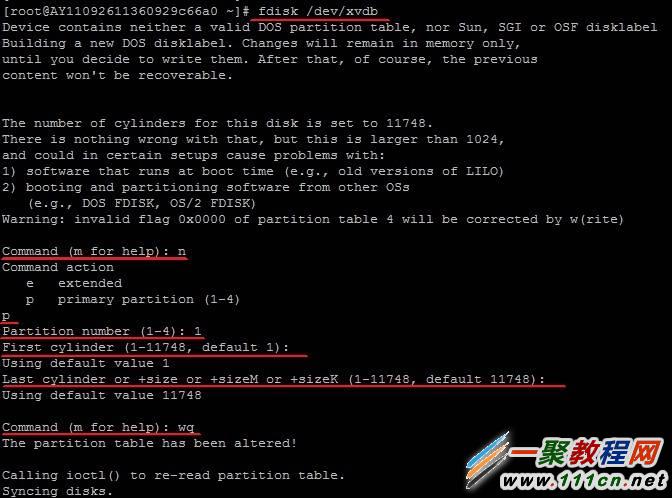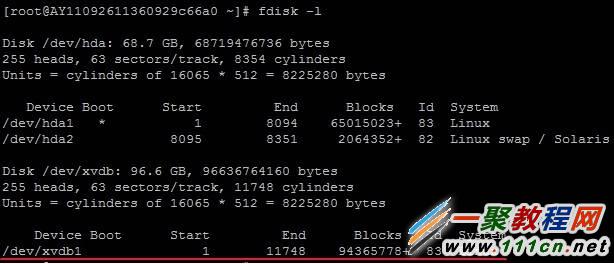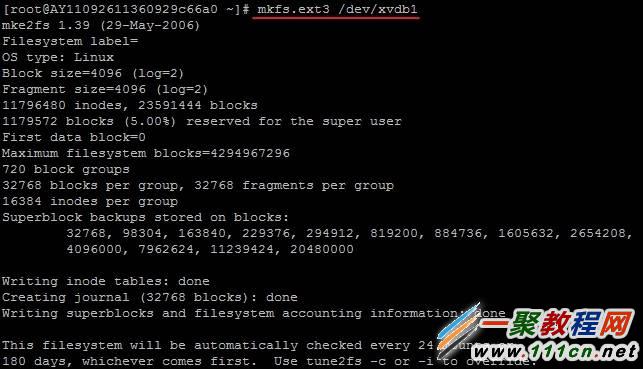Linux系统挂载数据盘演示与一键挂载数据盘脚本
然后使用“cat /etc/fstab”命令查看,出现以下信息就表示写入成功。
到这里你就完成了数据盘的挂载
下面分享一个脚本,一个挂载数据盘的脚本,只需运行脚本即可挂载数据盘,且数据盘挂载路径为/a
count=0
tmp1=/tmp/.tmp1
tmp2=/tmp/.tmp2
>$tmp1
>$tmp2
fstab_file=/etc/fstab
#check lock file ,one time only let the script run one time
LOCKfile=/tmp/.$(basename $0)
if [ -f "$LOCKfile" ]
then
echo -e "�33[1;40;31mThe script is already exist,please next time to run this script.�33[0m"
exit
else
echo -e "�33[40;32mStep 1.No lock file,begin to create lock file and continue.�33[40;37m"
touch $LOCKfile
fi
#check user
if [ $(id -u) != "0" ]
then
echo -e "�33[1;40;31mError: You must be root to run this script, please use root to install this script.�33[0m"
rm -rf $LOCKfile
exit 1
fi
#check disk partition
check_disk()
{
>$LOCKfile
device_list=$(fdisk -l|grep "Disk"|grep "/dev"|awk '{print $2}'|awk -F: '{print $1}'|grep "xv")
for i in `echo $device_list`
do
device_count=$(fdisk -l $i|grep "$i"|awk '{print $2}'|awk -F: '{print $1}'|wc -l)
echo
if [ $device_count -lt 2 ]
then
now_mount=$(df -h)
if echo $now_mount|grep -w "$i" >/dev/null 2>&1
then
echo -e "�33[40;32mThe $i disk is mounted.�33[40;37m"
else
echo $i >>$LOCKfile
echo "You have a free disk,Now will fdisk it and mount it."
fi
fi
done
disk_list=$(cat $LOCKfile)
if [ "X$disk_list" == "X" ]
then
echo -e "�33[1;40;31mNo free disk need to be fdisk.Exit script.�33[0m"
rm -rf $LOCKfile
exit 0
else
echo -e "�33[40;32mThis system have free disk :�33[40;37m"
for i in `echo $disk_list`
do
echo "$i"
count=$((count+1))
done
fi
}
#fdisk ,formating and create the file system
fdisk_fun()
{
fdisk -S 56 $1 << EOF
n
p
1
wq
EOF
sleep 5
mkfs.ext3 ${1}1
}
#make directory
make_dir()
{
echo -e "�33[40;32mStep 4.Begin to make directory�33[40;37m"
for j in `seq $count`
do
if [ -d "/a" ]
then
echo -e "�33[1;40;31m/a is exists.This script will exit,you must to choose a directory for mount.�33[0m"
rm -rf $LOCKfile $tmp2
exit
else
echo "/a" >>$tmp1
mkdir /a
fi
done
}
#config /etc/fstab and mount device
main()
{
for i in `echo $disk_list`
do
echo -e "�33[40;32mStep 3.Begin to fdisk free disk.�33[40;37m"
fdisk_fun $i
echo "${i}1" >>$tmp2
done
make_dir
>$LOCKfile
paste $tmp2 $tmp1 >$LOCKfile
echo -e "�33[40;32mStep 5.Begin to write configuration to /etc/fstab and mount device.�33[40;37m"
while read a b
do
if grep -v ^# $fstab_file|grep ${a} >/dev/null
then
sed -i "s=${a}*=#&=" $fstab_file
fi
echo "${a} $b ext3 defaults 0 0" >>$fstab_file
done <$LOCKfile
mount -a
}
#=========start script===========
echo -e "�33[40;32mStep 2.Begin to check free disk.�33[40;37m"
check_disk
main
df -h
rm -rf $LOCKfile $tmp1 $tmp2




















